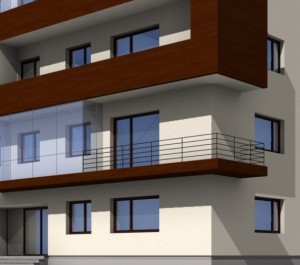Dark diagonals on window glass panes
ByI didn’t intend to write an article about materials just yet – it’s still “work in progress” – but I have stumbled on a bit of interesting phenomena regarding glass and I thought it best to get it here while it’s hot. It’s also a modelling problem in a way.
I used to model the glass pane as a solid object in another 3d software, that is as a thin box, it seemed to work better like this.
I did this in Blender at first also but after setting transparency and reflectivity to the glass material I got an unexpected black diagonal line across my window, as you can see on the window in the middle of the render. The other windows are made from a simple plane.
Here are the settings I used (I’m still working to improve them):
As you can see I was using Ztransp because I had read somewhere it’s better for simple architectural glass. I am still testing this idea. Glass in architecture visualisations doesn’t need all the fancy glass characteristics of 3d artwork glass like caustics and refraction so Ztransp sounded good. Refraction can cause unwanted distortions in this kind of project though I didn’t notice that in Blender.
First I checked the object properties and my glass object was solid, the faces were quads and the normals properly oriented. I moved the light a bit but got the same effect.
After some more tests I managed to find the problem, the black diagonal happened because of the Ztransp transparency in conjunction with the raytraced shadow and the small distance between the two faces of the object. I looked at the shadow settings in the lights panel but couldn’t find anything there. So one solution is to leave Ztransp alone and use raytraced transparency. It might not be so bad but I’ll have to make some more tests to find the exact difference between the two methods.
I found that to keep using Ztransp you have to either make the glass from a single plane OR turn off the “traceable” button in the Links and pipeline panel (in the material buttons). This will stop the material from casting raytraced shadows which was not a problem in my example.
I should note some wierdness that happened while I was switching between raytraced transparency and Ztrans, like the setting didn’t update at once, but I’m not sure, I’ll look into that again.
Definitely I will have to dig some more into the “glass” topic.
-
Mohamed
-
Oana
-
Treva Van Fossen



